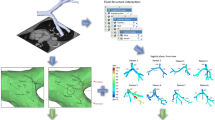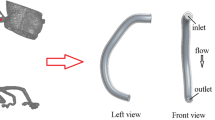Abstract
Hemodynamic wall shear stress (WSS) plays an important role in the initiation and progression of carotid atherosclerosis. This study aims at developing a technique to model WSS distribution based on point-wise geometric features that can be efficiently computed. Computational fluid dynamic analysis was performed for ten subjects. Surface curvatures, vascular radius, rate of change of radius along the longitudinal direction and standardized longitudinal/circumferential coordinates were computed on a point-wise basis for the arteries. Each of these point-wise geometric parameters was transformed to maximize the adjusted correlation coefficient. The transformed geometric parameters subsequently served as input variables of a multiple regression model. Multiple regression analysis revealed a significant relationship (\(p<0.0001\)) between WSS and three geometric parameters in internal and external carotid arteries (ICA and ECA). These three geometric parameters include vascular radius (ICA: \(\beta = 0.50\), ECA: \(\beta = 0.23\)), standardized longitudinal/circumference coordinates (ICA: \(\beta = 0.16\), ECA: \(\beta = 0.27\)) and Gaussian curvature (ICA: \(\beta = -0.24\), ECA: \(\beta = -0.19\)). The results suggest that the proposed geometric parameters can serve as risk indicator in large-scale clinical studies aiming at elucidating the roles of local geometric risk of atherosclerosis.





Similar content being viewed by others
References
Antiga L, Ene-Iordache B, Remuzzi A (2003) Computational geometry for patient-specific reconstruction and meshing of blood vessels from MR and CT angiography. IEEE Trans Med Imaging 22(5):674–684
Antiga L, Piccinelli M, Botti L, Ene-Iordache B, Remuzzi A, Steinman DA (2008) An image-based modeling framework for patient-specific computational hemodynamics. Med Biol Eng Comput 46(11):1097–1112
Antiga L, Steinman DA (2004) Robust and objective decomposition and mapping of bifurcating vessels. IEEE Trans Med Imaging 23(6):704–713
Bijari PB, Antiga L, Gallo D, Wasserman BA, Steinman DA (2012) Improved prediction of disturbed flow via hemodynamically-inspired geometric variables. J Biomech 45(9):1632–1637
Bissell C, Chapman D (1992) Digital signal transmission, 2nd edn. Cambridge University Press, Cambridge
Canton G, Chiu B, Chen H, Chen Y, Hatsukami TS, Kerwin WS, Yuan C (2013) A framework for the co-registration of hemodynamic forces and atherosclerotic plaque components. Physiol Meas 34(9):977–990
Caro CG (2009) Discovery of the role of wall shear in atherosclerosis. Arterioscler Thromb Vasc Biol 29(2):158–161
Caro CG, Fitz-Gerald JM, Schroter RC (1969) Arterial wall shear and distribution of early atheroma in man. Nature 223(5211):1159–1160
Chiu B, Beletsky V, Spence JD, Parraga G, Fenster A (2009) Analysis of carotid lumen surface morphology using three-dimensional ultrasound imaging. Phys Med Biol 54(5):1149–1167
Chiu B, Chen Y, Canton G, Kerwin WS (2013) Relationships between local geometrical features and hemodynamic flow properties. Conf Proc IEEE Eng Med Biol Soc 2013:723–726. doi:10.1109/EMBC.2013.6609602
Eicke BM, Von Lorentz J, Paulus W (1995) Embolus detection in different degrees of carotid disease. Neurol. Res. 17(3):181
Feigin VL, Krishnamurthi R (2011) Stroke prevention in the developing world. Stroke 42(12):3655–3658
Filipovic N, Teng Z, Radovic M, Saveljic I, Fotiadis D, Parodi O (2013) Computer simulation of three-dimensional plaque formation and progression in the carotid artery. Med Biol Eng Comput 51(6):607–616
Friedman MH, Deters OJ, Mark FF, Bargeron CB, Hutchins GM (1983) Arterial geometry affects hemodynamics: a potential risk factor for atherosclerosis. Atherosclerosis 46(2):225–231
Gallo D, Steinman DA, Morbiducci U (2015) An insight into the mechanistic role of the common carotid artery on the hemodynamics at the carotid bifurcation. Ann Biomed Eng 43(1):68–81
Glor F, Long Q, Hughes A, Augst A, Ariff B, Thom SM, Verdonck P, Xu X (2003) Reproducibility study of magnetic resonance image-based computational fluid dynamics prediction of carotid bifurcation flow. Ann Biomed Eng 31(2):142–151
Gnasso A, Irace C, Carallo C, De Franceschi MS, Motti C, Mattioli PL, Pujia A (1997) In vivo association between low wall shear stress and plaque in subjects with asymmetrical carotid atherosclerosis. Stroke 28(5):993–998
Gorelick PB (1994) Stroke prevention. An opportunity for efficient utilization of health care resources during the coming decade. Stroke 25(1):220–224
He J, Gu D, Wu X, Reynolds K, Duan X, Yao C, Wang J, Chen CS, Chen J, Wildman RP, Klag MJ, Whelton PK (2005) Major causes of death among men and women in China. N Engl J Med 353(11):1124–1134
Hoi Y, Wasserman BA, Lakatta EG, Steinman DA (2010) Carotid bifurcation hemodynamics in older adults: effect of measured versus assumed flow waveform. J. Biomech. Eng. 132(7):071006
Kerwin W, Xu D, Liu F, Saam T, Underhill H, Takaya N, Chu B, Hatsukami T, Yuan C (2007) Magnetic resonance imaging of carotid atherosclerosis: plaque analysis. Top. Magn. Reson. Imaging 18(5):371–378
Ku DN, Giddens DP, Zarins CK, Glagov S (1985) Pulsatile flow and atherosclerosis in the human carotid bifurcation. Positive correlation between plaque location and low oscillating shear stress. Arterioscler Thromb Vasc Biol 5(3):293–302
Ladak HM, Thomas JB, Mitchell JR, Rutt BK, Steinman DA (2001) A semi-automatic technique for measurement of arterial wall from black blood MRI. Med Phys 28(6):1098–1107
Lee SW, Antiga L, Spence JD, Steinman DA (2008) Geometry of the carotid bifurcation predicts its exposure to disturbed flow. Stroke 39(8):2341–2347
Long Q, Xu XY, Ariff B, Thom SA, Hughes AD, Stanton AV (2000) Reconstruction of blood flow patterns in a human carotid bifurcation: a combined CFD and MRI study. J Magn Reson Imaging 11(3):299–311
Mackay J, Mensah GA (2004) The atlas of heart disease and stroke. World Health Organization, Geneva
Malek AM, Alper SL, Izumo S (1999) Hemodynamic shear stress and its role in atherosclerosis. J Am Med Assoc 282(21):2035–2042
Markl M, Wegent F, Zech T, Bauer S, Strecker C, Schumacher M, Weiller C, Hennig J, Harloff A (2010) In-vivo wall shear stress distribution in the carotid artery: effect of bifurcation geometry, internal carotid artery stenosis and recanalization therapy. Circul Cardiovasc Imaging 3(6):647–655
Marshall I, Zhao S, Papathanasopoulou P, Hoskins P, Xu XY (2004) MRI and CFD studies of pulsatile flow in healthy and stenosed carotid bifurcation models. J Biomech 37(5):679–687
Perktold K, Thurner E, Kenner T (1994) Flow and stress characteristics in rigid walled and compliant carotid artery bifurcation models. Med Biol Eng Comput 32(1):19–26
Persson PO, Strang G (2004) A simple mesh generator in MATLAB. SIAM Rev 46(2):329–345
Sangalli LM, Secchi P, Vantini S, Veneziani A (2009) Efficient estimation of three-dimensional curves and their derivatives by free-knot regression splines, applied to the analysis of inner carotid artery centrelines. J R Stat Soc Ser C Appl Stat 58(3):285–306
Shaaban AM, Duerinckx AJ (2000) Wall shear stress and early atherosclerosis a review. Am J Roentgenol 174(6):1657–1665
Slager C, Wentzel J, Gijsen F, Thury A, Van der Wal A, Schaar J, Serruys P (2005) The role of shear stress in the destabilization of vulnerable plaques and related therapeutic implications. Nat Clin Pract Cardiovasc Med 2(9):456–464
Steinke W, Kloetzsch C, Hennerici M (1990) Variability of flow patterns in the normal carotid bifurcation. Atherosclerosis 84(2):121–127
Steinman DA (2002) Image-based computational fluid dynamics modeling in realistic arterial geometries. Ann Biomed Eng 30(4):483–497
Tang D, Yang C, Mondal S, Liu F, Canton G, Hatsukami TS, Yuan C (2008) A negative correlation between human carotid atherosclerotic plaque progression and plaque wall stress: In vivo MRI-based 2D/3D FSI models. J Biomech 41(4):727–736
Taylor CA, Steinman DA (2010) Image-based modeling of blood flow and vessel wall dynamics: applications, methods and future directions. Ann Biomed Eng 38(3):1188–1203
Thomas JB, Milner JS, Steinman DA (2002) On the influence of vessel planarity on local hemodynamics at the human carotid bifurcation. Biorheology 39(3):443–448
Yang C, Canton G, Yuan C, Ferguson M, Hatsukami TS, Tang D (2010) Advanced human carotid plaque progression correlates positively with flow shear stress using follow-up scan data: An in vivo MRI multi-patient 3D FSI study. J Biomech 43(13):2530–2538
Acknowledgments
This study is supported by Grants from the Research Grant Council of the HKSAR, China (Project No. CityU 139713), the National Natural Science Foundation of China (Grant No. 81201149). Subject data came from studies supported by the National Institute of Health (R01 HL073401, R01 HL61851 and P01 HL072262) and we acknowledge the support.
Author information
Authors and Affiliations
Corresponding author
Appendix: Relationship between patch-wise RMSE and point-wise RMSE
Appendix: Relationship between patch-wise RMSE and point-wise RMSE
Suppose the carotid surface is divided into p patches, and each of the patches consists of \(T/p = n\) points, where T is the total number of points on a carotid surface. With the following notations defined,
- \(d_{ij} \triangleq\) :
-
WSS error on point j of patch i
- \(d_{i,rms} \triangleq\) :
-
point-wise RMS deviation within patch i
- \(\overline{d_{i}} \triangleq\) :
-
average error in patch i
- \(\sigma _{d,i}^2 \triangleq\) :
-
variance of point-wise error in patch i
it can be shown that the square of the point-wise RMS difference is the sum of the square of patch-wise difference and the variance of the point-wise difference [5]:
The square of the point-wise RMSE over the whole carotid, denoted by \(d_{\mathrm{rmse}}^2\), can be expressed as:
The second equality holds because \(d_{i, \mathrm{rms}}^2 = (1/n)\sum _{j=1}^{n}d_{ij}^2\). The square of the patch-wise RMSE over the whole carotid, denoted by \(P_{\mathrm{rmse}}^2\), can be expressed as:
Rearranging Eqs. 13 and 14 yields
Rights and permissions
About this article
Cite this article
Chen, Y., Canton, G., Kerwin, W.S. et al. Modeling hemodynamic forces in carotid artery based on local geometric features. Med Biol Eng Comput 54, 1437–1452 (2016). https://doi.org/10.1007/s11517-015-1417-1
Received:
Accepted:
Published:
Issue Date:
DOI: https://doi.org/10.1007/s11517-015-1417-1




